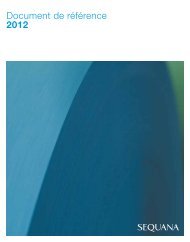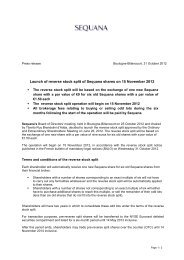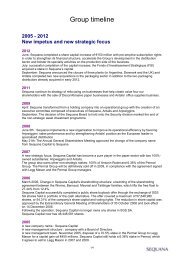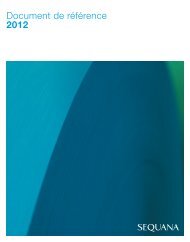Contents
Registration document PDF - Sequana
Registration document PDF - Sequana
You also want an ePaper? Increase the reach of your titles
YUMPU automatically turns print PDFs into web optimized ePapers that Google loves.
Financial position – resultsNotes to the consolidated financial statements 4Methods and assumptions used to measure financialinstrumentsThe best indicator of the fair value of a contract is the price thatwould be agreed upon by a buyer and a seller acting under arm’slength conditions. This is generally the transaction price at thetrade date. The contract is subsequently measured using observablemarket data that provide the most reliable indicator of fairvalue.The fair value of derivative instruments is determined as follows:■■interest rate swaps are measured by discounting contractualcash flows to present value;■■options are measured using option pricing models such as theBlack & Scholes method that use quoted prices from an activemarket and/or prices supplied by outside financial institutions;■■forward currency contracts are measured by discounting thedifferential future cash flows to present value;■■commodity derivatives are valued as follows:• futures traded on an organised market are marked to market;• swaps and forward contracts traded over the counter: futurecash flows are discounted to present value;• options are measured using mathematical option pricingmodels.The fair value of debt is measured using the amortised costmethod.Trade receivables and payables are measured at their carryingamount. Discounting “Trade payables” and “Trade receivables”balances to present value does not materially impact their fairvalue due to the very short payment and settlement terms applied.The information used for the financial instruments recorded in fairvalue in assets/liabilities is provided by external counterparties.18b - Treasury management - Financial instrumentsAnalysis of debtConsolidated debt – which represented a gross amount of €723 million at 31 December 2012 (31 December 2011: €934 million) – is financedon an individual basis within the Group’s holding companies and subsidiaries. Consolidated net debt totalled €538 million at end-2012 (end-2011: €609 million) and is carried in the following statement of financial position captions:(€ millions) 31/12/2012 31/12/2011Debt (Note 17) 723 934Cash and cash equivalents (Note 11) (183) (323)Other marketable securities (Note 8) (2) (2)NET DEBT 538 609Analysis by business segment:(€ millions) 31/12/2012 31/12/2011Antalis 245 226Arjowiggins 275 314Holding companies 18 69NET DEBT 538 609Analyses by maturity and by currency are provided in Note 17.The following section provides details of current financingarrangements for each entity.ArjowigginsArjowiggins’ gross debt amounted to €351 million at the end of2012 (end-2011: €435 million). Of this total, 94.1% representeddrawdowns on the €400 million confirmed and syndicated creditline described in Note 17.At 31 December 2012, the Group had drawn down €330 million ofthis credit facility and the average outstanding amount over theyear was €389 million. The weighted average maturity of drawdownsin 2012 was 32 days.In addition to this renegotiated confirmed credit facility,Arjowiggins SAS’ pool of banks has granted it unconfirmedoverdraft facilities of up to €52 million. These facilities had notbeen availed of at 31 December 2012.In 2012, Arjowiggins also received financing through its deconsolidatingfactoring programmes (see below).At 31 December 2012, the group had raised a net amount of€79 million under the programme which helped to reduce its netdebt. The amount raised in 2011 was €97 million.Sequana | 2012 Document de référence (English version) | 135









